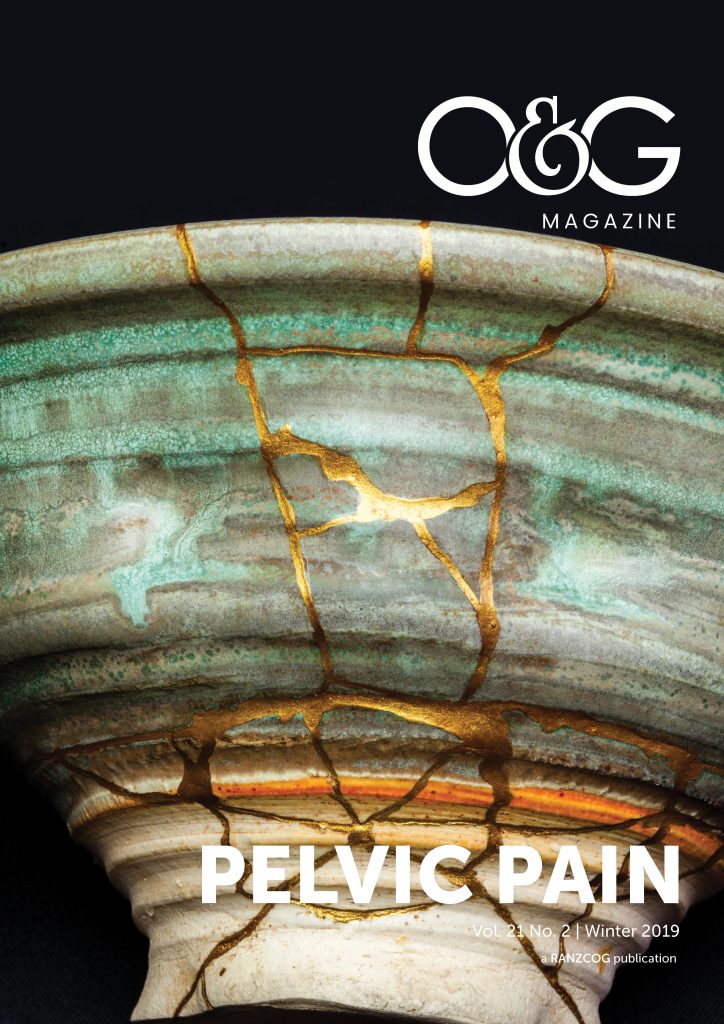‘I have had lots of ultrasounds, but no one can ever tell me why I have pain.’ Sadly, this is an all-too-common refrain from women suffering pelvic pain. Ultrasound can be a very valuable imaging tool for the assessment of pelvic pain, but it has its limitations. Understanding what it ‘can and cannot see’ is very important for maximising its clinical efficacy. When pelvic ultrasound is limited to the assessment of the uterus, endometrium and ovaries, many causes of pelvic pain will be missed or misdiagnosed. A more complete assessment, which incorporates the Pouch of Douglas and the uterosacral ligaments, has been described and widely published in recent years.1 2
Pelvic pain is a complex and diverse medical problem. Delayed diagnosis and misdiagnosis are common problems, with the median time interval from first experience of symptoms to a diagnosis of seven years.3 This has been reported for endometriosis, but is also relatively common for other gynaecological conditions causing, or contributing to, pelvic pain. There is considerable overlap between the causes of acute and chronic pelvic pain. The initial consultation with a health provider is of crucial importance. Establishing trust and arriving at a timely diagnosis can prevent many causes of pelvic pain progressing to a chronic pain condition.4 5
Medical imaging has often been inadequate in providing the answers that patients and gynaecologists need to manage pain. The investigations for pelvic pain must consider the broad range of possible aetiologies and comorbidities. Correct use and interpretation of medical imaging needs to take account of whether the pain is acute or chronic, as well as individual patient considerations such as age, prior surgery and use of hormonal medications. Providing this information to your medical imaging team is very important to allow a thorough and complete investigation. As clinicians, you have an important role in providing this information. An appropriately detailed referral or request form will allow your radiologist or COGU to provide a more complete and clinically pertinent report.
Table 1. Things your imaging specialist wants to know
| Factor | What to include |
| Nature of the pain | Duration, cyclical/non-cyclical, location of pain |
| Comorbidities | Other medical conditions that may be relevant |
| Age | Premenarchal, reproductive age, peri- or post-menopausal |
| Use of hormonal medications | Mirena, Implanon, OCP, HRT |
| Prior surgery | |
| Gynaecology and obstetric history |
While there is a role for MRI and CT scanning in the investigation of some forms of pelvic pain, ultrasound remains the investigation of first choice. It is readily available, relatively inexpensive and free from radiation. It provides high-resolution imaging of pelvic organs and, importantly, is a dynamic real-time assessment, allowing the localisation of pain and assessment of tissue mobility.
A disadvantage of ultrasound is that it is operator-dependant, and the ability to review or reassess images can be limited. The preferred imaging modality may relate to the local expertise in this area.
Acute pelvic pain
Acute abdominal and pelvic pain often presents as a diagnostic dilemma between gynaecological and general surgical teams. Imaging is central to establishing the diagnosis. Once pregnancy-related complications have been excluded with a current negative beta human chorionic gonadotropin test, ultrasound remains the first line in medical imaging. This article will not cover pregnancy-related causes of pelvic pain.
Ultrasound is useful in the diagnosis of many of the conditions listed in Table 2. Transvaginal (TV) sonography performs well in the diagnosis of pelvic inflammatory disease6, ovarian cysts and some forms of torsion. The difficulty with the diagnosis of ovarian cysts as causes of acute pelvic pain is that they are common, often transient, and may be an incidental, rather than causative, finding. Approximately 7 per cent of asymptomatic pre-menopausal women will have a cyst greater than 25 mm, and 7 per cent of postmenopausal women will have a cyst greater than or equal to 15 mm.7 8 Complications of a cyst, such as internal haemorrhage or rupture, are readily identified with TV ultrasound.
Table 2. Types of acute pelvic pain
| Adnexal | Uterine | Non-gynaecological |
|
|
|
Torsion is a partial or complete rotation of the adnexal structures around their vascular pedicle and can involve the ovary, tube or entire adnexa. Torsion is relatively common, representing approximately 3 per cent of presentations to emergency departments.9 Given the risk of adnexal necrosis, a timely diagnosis is important. Torsion creates a diffuse enlargement of the adnexal structure secondary to the oedema. It must be remembered that torsion remains a clinical diagnosis that cannot be completely excluded or confirmed with imaging. The most predictive imaging findings where torsion has been confirmed surgically are adnexal enlargement (90 percent greater than 5 cm in size) and displacement of the ovary to a position superior to uterus or to the contralateral pelvis. Doppler can be misleading, with up to 50 per cent of cases of torsion demonstrating normal blood flow patterns.10 This is likely secondary to the varied degrees of arterial, venous and lymphatic occlusion. Absence of blood flow to the adnexa has a high positive predictive value for torsion, but is a late sign and indicates a degree of necrosis.11 In the premenarchal paediatric group, torsion often occurs in the setting of a normal ovary and tube.
Congenital anomalies of the uterus and vagina in the adolescent population may present acutely secondary to the haematocolpos or haematometra. These conditions can be mislabelled as ovarian masses, typically endometriomas.
Non-gynaecological causes of pelvic pain should be assessed with every scan. Appendicitis is a common cause of acute right lower quadrant pain and imaging is often used in the less obvious clinical presentations. The sensitivity of transabdominal/TV ultrasound for acute appendicitis ranges from 75–90 per cent.12 Diverticulitis presents as lower left quadrant pain in adults. Ultrasound offers similar sensitivity and specificity to CT scanning.
Chronic pelvic pain
Chronic pelvic pain is a condition defined as pelvic pain present for more than six months that is severe enough to cause functional disability or require treatment.13 Chronic pelvic pain presents as frequently to the medical system as migraine or lower back pain14 and is associated with significant impairment in quality of life and significant economic implications. Endometriosis alone is estimated to affect 176 million women worldwide,15 with pain accounting for approximately 20 per cent of hysterectomies for benign conditions and at least 40 per cent of gynaecological laparoscopies.16 The aetiologies of chronic pain are more complex and diverse, and it is more frequently associated with significant comorbidities, such as, irritable bowel syndrome 50 per cent and interstitial cystitis 38–84 per cent.17 Musculoskeletal pain arising from the pelvic floor is common.
Table 3. Types of chronic pelvic pain
| Adnexal | Uterine | Non-gynaecological |
|
|
|
The efficacy of ultrasound in the investigation of chronic pelvic pain has not been well evaluated, but it has been reported that up to 20 per cent of patients undergoing ultrasound for chronic pelvic pain will have abnormalities identified.18 TV ultrasound performs well in identifying structural anomalies such as adnexal/ovarian pathology, adenomyosis and fibroids, but these may be incidental findings and not the cause of the pain. MRI and TV ultrasound perform well and similarly in the identification of deep endometriosis. There have been recent publications outlining a systematic approach to the ultrasound evaluation of deep endometriosis. It is an important preoperative investigation to locate lesions of deep infiltrating endometriosis and to adequately consent patients and plan surgery. MRI remains the second line investigation, owing to cost and availability. MRI is particularly useful to use in conjunction with TV ultrasound imaging or in patients where TV ultrasound is not acceptable, where the origin or nature of pathology is uncertain, or where immobility of the pelvis has limited assessment of the upper rectal wall. This is often encountered with severe endometriosis/adhesive disease or when large fibroids or ovarian masses fill the pelvis.
The use of medical imaging to provide a non-invasive diagnosis for peritoneal or superficial endometriosis remains the next frontier. A Cochrane review concluded that no imaging modality could detect pelvic endometriosis with enough accuracy to replace surgery.19 A study assessing the role of ‘soft markers’ in ultrasound found a LR of 1.9 for the presence of these markers and positive findings at laparoscopy.20 A more recent study identified a correlation of 79 per cent of ultrasound findings of inflammatory change (thickened uterosacral ligaments and pericolic fat) and positive findings of endometriosis at laparoscopy.21
The ability of ultrasound to diagnose peritoneal/superficial forms of endometriosis is the current challenge. This would reduce the reliance on diagnostic laparoscopy and allow patients and their doctors greater insight into the cause of their pain.
References
- S Guerrero, et al. Systematic approach to sonographic evaluation of the pelvis in women with suspected endometriosis, including terms, definitions and measurements: a consensus opinion from the international deep endometriosis analysis (IDEA) group. Ultrasound Obstet Gynecol. 2016;48:318-32.
- M Goncalves, et al. Transvaginal ultrasound for diagnosis of deep infiltrating endometriosis. International J Obst and Gynecol. 2009;104:156-60.
- H Taylor, et al. An evidence-based approach to assessing surgical versus clinical diagnosis of symptomatic endometriosis. International J Obst and Gynecol. 2018;142:131-42.
- G Harkins G. Female pelvic pain. Semin Reprod Med. 2018;36:97-8.
- The initial management of chronic pelvic pain. RCOG: Green Top Guidelines, No. 41, May 2012.
- E Okaro, L Valentin. Best Practice and Research. Clin Obst and Gynaecol. 2004;18:105-23.
- E Okaro, L Valentin. Best Practice and Research. Clin Obst and Gynaecol. 2004;18:105-23.
- C Conway. Simple cyst in the post-menopausal patient: detection and management. Journal of Ultrasound in Medicine. 1998;17:369-372.
- P Callen. Ultrasonography in Obstetrics and Gynaecology, 6th Edition, Elsevier, 2016.
- P Callen. Ultrasonography in Obstetrics and Gynaecology, 6th Edition, Elsevier, 2016.
- P Callen. Ultrasonography in Obstetrics and Gynaecology, 6th Edition, Elsevier, 2016.
- E Okaro, L Valentin. Best Practice and Research. Clin Obst and Gynaecol. 2004;18:105-23.
- J Chandler. Evaluation of female pelvic pain. Seminars in Reproductive Medicine. 2018;36:99-106.
- The initial management of chronic pelvic pain. RCOG: Green Top Guidelines, No. 41, May 2012.
- D Bush, S Evans. The $6 Billion Woman and the $600 Million Girl. 2011: The Pelvic Pain report. Available from: http://fpm.anzca.edu.au/documents/pelvic_pain_report_rfs.pdf.
- J Chandler. Evaluation of female pelvic pain. Seminars in Reproductive Medicine. 2018;36:99-106.
- The initial management of chronic pelvic pain. RCOG: Green Top Guidelines, No. 41, May 2012.
- E Okaro, G Condous, et al. The use of ultrasound-based ‘soft markers’ for the prediction of pelvic pathology in women with chronic pelvic pain – can we reduce the need for laparoscopy? BJOG. 2006,113:251-56.
- V Nienblat, PMM Bossuyt, C Farquhar, et al. Imaging modalities for the non-invasive diagnosis of endometriosis (Review). Cochrane Database of Syst Rev. 2016, Issue 2.
- E Okaro, G Condous, et al. The use of ultrasound-based ‘soft markers’ for the prediction of pelvic pathology in women with chronic pelvic pain – can we reduce the need for laparoscopy? BJOG. 2006,113:251-56.
- P Chowdary, K Stone. Multicentre retrospective study to assess the diagnostic accuracy of ultrasound for superficial endometriosis – are we any closer? ANZJOG. 2019;59:279-84.






Leave a Reply